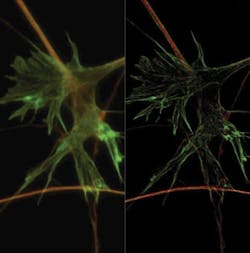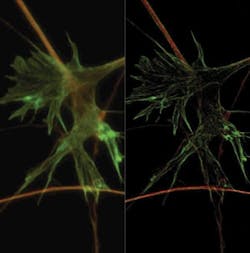Seek and destroy tumors, and report, "mission accomplished"
Scientists at the University of California, Berkeley have created nanoprobes that not only selectively seek and destroy tumor cells, but also report the status of their work. The team's innovation involved combining different materials–roughened gold on one side, and smooth polystyrene on the other–onto a single, multi-functioning "nanocoral." The name was inspired by natural sea corals, which use rough surfaces to capture light and food. The nanocoral surface captures molecules near the probes, and reports their presence, said Ph.D. student Benjamin Ross, one of two co-lead authors of the study reported in the February 22 issue of the journal Small. "The type of molecules present–or absent–at the cell's surface can provide telltale signs of how a cell is reacting to the new drug being delivered," he explained.
The technique uses surface-enhanced Raman spectroscopy (SERS), which takes advantage of electromagnetic excitations that occur as molecules make contact with the roughened surface of a metal. Molecules produce oscillations that resonate at signature frequencies when exposed to laser light, revealing their presence to the scientists.
The researchers verified the sensitivity of the nanocoral by measuring its ability to detect a standard chemical compound for Raman spectroscopy. To get the nanocoral to target specific cells, they leveraged the capability to attach antibodies to polymer surfaces. "We can tailor the nanocoral to cancer cells of interest by attaching the appropriate antibodies," said the study's other co-lead author, Liz Wu. The researchers demonstrated this concept by coating the polystyrene surface with antibodies that attack human epidermal growth factor receptor 2 (HER-2). They confirmed with both bright field and fluorescent images that the nanocoral attached to breast cancer cells with HER-2 receptors, while control experiments showed that no binding occurred when different antibodies or when cells lacking HER-2 were used.
More Brand Name Current Issue Articles
More Brand Name Archives Issue Articles

